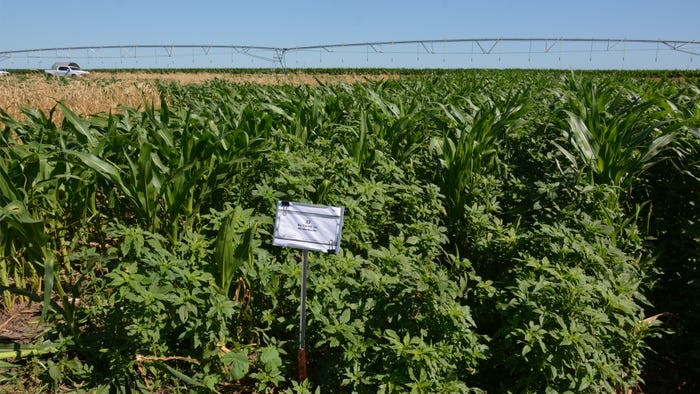Palmer amaranth. It’s been creeping into fields across the Midwest. But this pesky weed is not new to corn and soybean fields. With Palmer becoming more herbicide-resistant, this pushes producers to find new ways to control it, such as using a rye cover crop to suppress it.
At a recent University of Nebraska weed management field day near Clay Center, research on Palmer amaranth topped the list of discussion topics.
Whether you are a farmer having trouble controlling this weed or just looking to reduce chemical inputs, planting green is a viable option. This means planting the primary crop directly into the green cover crop. Producers can also terminate the cover crop a couple of weeks before planting their primary crop.
The Palmer plant tends to stick around because, according to UNL Invasive Species Program research, a single female plant can produce 1 million seeds per year, and seeds can remain viable for five years. Because of their tendency to stick around, an integrated approach can be helpful to assist producers.
Integrated Strategy
Amit Jhala, Nebraska Extension weed management specialist, and his team are researching the best time to plant and kill a cereal rye cover crop, with the goal of reducing Palmer amaranth germination.
“In this project, we planted cereal rye in the fall in the early parts of October,” Jhala says.
Once the rye is planted, it serves as a cover crop. A key part to this management strategy is killing the rye at the right time. Rye is a cereal crop just like corn, so it can become a competitor for sunlight and soil moisture if it is allowed to grow.
“Right now, we are terminating cover crops before planting corn and soybeans,” Jhala says. “So, usually, a week or two before planting corn and soybeans is the best to terminate. This can separate winter annual weeds because we plant in the fall.”

RYE IS RIGHT: Palmer amaranth can quickly become a problem in fields because there are so many seeds, and the seeds remain viable in the soil for more than five years. Using a cover crop like cereal rye can help mitigate the presence of this challenging weed.
By terminating rye before planting corn, producers can ensure that the cover crop does not compete with the corn. In addition, if the rye is allowed to grow for too long, the seeds can become a problem for the following year and become a weed for the next growing season.
After terminating the rye, a preemergence herbicide was applied to the field. In some of the studies, a postemergence herbicide was applied. However, there were minimal weeds present in the fields where a postemergence application was not used.
“Some Palmer has started coming up now, but it is only one or two plants in a block,” Jhala says. “The cereal rye biomass is helping to suppress the emergence of Palmer.”
In this research plot, there is a large seed bank of Palmer amaranth present. These test plots showed that a postemergence herbicide might not be necessary to control Palmer amaranth because of the weed suppression that cereal rye offers.
Planting Green
Nitrogen availability should be at the forefront of a producer’s mind when planting green. Cereal rye will take nitrogen out of the soil. To combat this, Jhala and his team applied nitrous ammonia in early spring, and then 25 pounds of nitrogen at planting in fields that were planted into a green cover crop. In addition, they applied 20 pounds of nitrogen postemergence.
While the cereal rye might initially take nitrogen out of the soil, when the rye is killed, the rye will start to decompose and add nitrogen back into the soil.
“If you come back in this plot after a month, you will see much better corn and all the cereal rye perfectly terminated,” Jhala says. “The rye will decompose and will release nitrogen that will be available for corn very late in the season.”
These plots were not irrigated, but with this year’s rainfall, this was not a limiting factor. However, if the field is not irrigated, take into consideration the height of the cereal rye and the available water.
“So, at the end of the day, the take-home message from this project is that you may need to consider the weather and how the cereal rye is growing,” Jhala says. “Then you can decide at what time you can terminate, because with a year like this, I would suggest terminating at emergence time or at the V1 growth stage.”
Producers should take nitrogen availability, water resources and timely termination into consideration when planting green with cereal rye to control Palmer amaranth growth. With proper management, chemical usage can be reduced while decreasing Palmer emergence in fields.

.png?t=1723055487&width=700)




